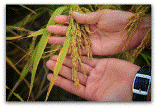Plant Pathology, Department of

Fungal Molecular Plant-Microbe Interactions
Date of this Version
2001
Document Type
Article
Citation
Molecular Plant–Microbe Interactions (2001) 14(8): 980–987. Publication number M-2001-0426-01R
Abstract
Maize kernels are highly susceptible to Aspergillus spp. infection and aflatoxin (AF) contamination. Fatty acid signaling molecules appear to mediate the plant–fungal interaction by affecting the growth, development, and AF production of the fungus. In particular, fatty acid derivatives of the plant lipoxygenase (LOX) pathway are implicated in the Aspergillus spp.-seed interaction. The 9(S)-hydroperoxide derivative of linoleic acid promotes transcription of AF genes, whereas the 13(S)-hydroperoxide derivative decreases AF gene expression and production; both are sporulation factors. Our goal was to identify LOX genes responsive to Aspergillus spp. colonization and determine their specificities, 9(S)- or 13(S)-. Screening maize LOX expressed sequence tags (ESTs) identified one clone, cssap 92, which is highly expressed in Aspergillus spp.-infected seed susceptible to AF contamination and repressed in lines with resistance to AF contamination. The accumulation of cssap 92 transcript was similar during Fusarium spp. infection. The cDNA clone has 94% identity to the previously described L2 LOX gene from maize. Product-specificity analysis of the CSSAP 92 protein shows that it preferentially adds oxygen to carbon 9 of linoleic acid. Because 9(S)-hydroperoxy linoleic acid has been implicated as an aflatoxin-signaling molecule, it is possible that cssap 92 could be used as a biomarker that is indicative of AF resistance in maize lines.

